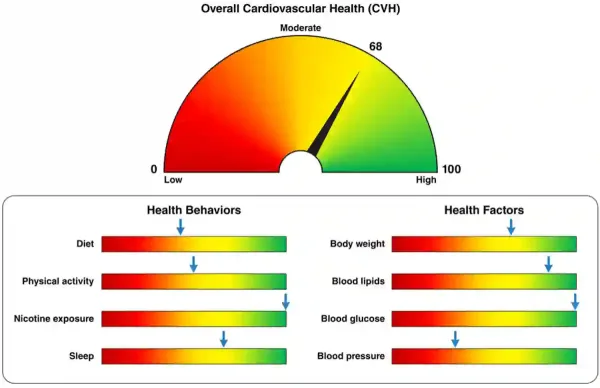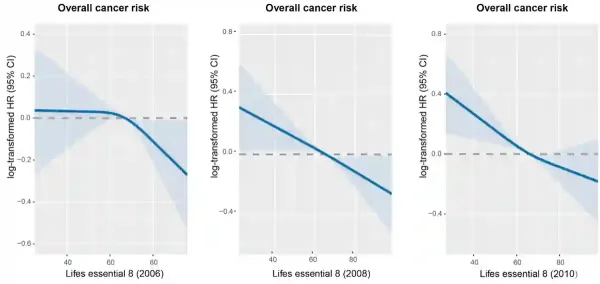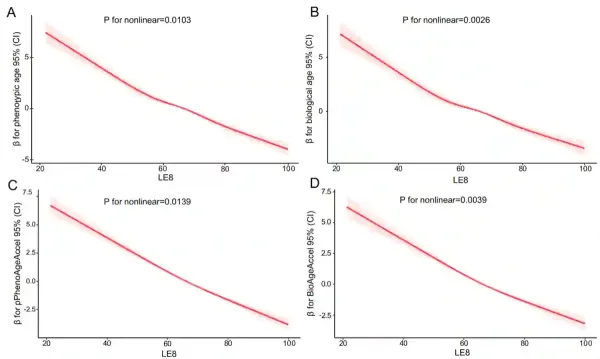Most people think of cancer risk as a roll of the genetic dice or something to worry about later. For most of us, however, the strongest risk predictor is not in our DNA but in our daily habits. A new study by Shi et al. from China tracked nearly 50,000 people over a decade and found that those who consistently scored high on eight lifestyle metrics dramatically lowered their risk of developing cancer. The study uncovered that the key was not a drastic or short-term change, but consistent healthy habits over time that shape our long-term health.
The Life’s Essential 8 (LE8) Scoring System
In 2022, the American Heart Association introduced the Life’s Essential 8 (LE8) framework for measuring cardiovascular health. Specifically, the LE8 score is built on eight components, divided into behavioural and biological categories. The behavioural elements include diet quality, physical activity, nicotine exposure and sleep health, while the biological ones assess body weight, blood pressure, blood glucose and blood lipids. Each component is scored on a scale from 0 to 100, and the overall LE8 score is the average of the eight. A higher score reflects better overall health, with scores above 80 considered high, 50–79 as moderate and below 50 as low (Figure 1). Essentially, by combining behavioural and biological factors into a single score, LE8 captures the full spectrum of health parameters that shape disease risk.
Figure 1. An example calculation of overall cardiovascular health (CVH) based on the Life’s Essential 8 (LE8) scoring system. The top gauge shows the CVH score on a scale from 0 (poor) to 100 (ideal). The bars below break down the LE8 score into eight areas: four behavioural metrics (i.e., healthy diet, physical activity, nicotine avoidance and healthy sleep) and four physiological metrics (i.e., healthy weight and healthy levels of blood lipids, blood glucose and blood pressure). Source: Lloyd-Jones et al. (2022), Circulation.
Unlike typical studies that measure health at a single point in time, Shi et al. tracked the LE8 scores of participants across three time points (i.e., 2006, 2008 and 2010) to capture consistent lifestyle patterns rather than short-lived efforts. Using trajectory modelling, they categorised participants into three long-term patterns based on how their scores evolved over time:
- Low-stable: Participants who consistently had low LE8 scores (average scores below 50 out of 100) across all three health check-ups. This indicates poor lifestyle habits and biological health markers over time.
- Moderate-stable: Participants with moderate LE8 scores (average between 50–79) at each of the three time points. This reflects somewhat healthy habits, but with room for improvement across multiple lifestyle or health domains.
- Elevated-stable: Participants who maintained high LE8 scores (80 or above) consistently over the 4-year tracking period. This suggests strong adherence to healthy lifestyle behaviours and well-controlled biological measures.
Life’s Essential 8 (LE8) and Cancer Risk
Once participants were grouped into the three LE8 trajectory patterns (low-stable, moderate-stable and elevated-stable), Shi et al. followed them for an average of 10.4 years to observe who developed cancer. Compared to those in the low-stable group, participants who maintained moderate-stable and elevated-stable LE8 scores had 15% and 21% lower risks of cancer, respectively. These reductions remained significant even after adjusting for other risk factors like age, sex, income, waist circumference, alcohol intake and sedentary behaviour, suggesting that the protective effects of a high LE8 score are independent of these variables.
To complement their trajectory analysis, the researchers also examined whether LE8 scores at a single point in time (in 2006, 2008, or 2010) were associated with future cancer risk. In each case, they observed a clear dose-response relationship: as LE8 scores increased, the risk of developing cancer decreased. This trend was consistent across all three time points, even after adjusting for other risk factors, thus reinforcing the idea that higher LE8 scores, even when measured once, can predict long-term cancer outcomes (Figure 2).
Figure 2. Higher Life’s Essential 8 (LE8) scores consistently predicted lower cancer risk over time. Across all three time points, participants with higher LE8 scores had a lower risk of developing cancer. The blue line represents the trend, while the shaded area shows the margin of uncertainty (95% confidence interval). These patterns remained significant even after adjusting for other factors like age, sex, income, alcohol use and sedentary behaviour. Source: Shi et al. (2025), Scientific Reports.
When broken down by cancer type, the protective effects of high LE8 scores were as follows:
- Breast cancer risk was reduced by 49% and 51% in the moderate-stable and elevated-stable groups, respectively.
- Liver cancer risk was reduced by 34% and 39% in the moderate-stable and elevated-stable groups, respectively.
- Colorectal cancer risk was reduced by 31% in the elevated-stable group.
- Lung cancer risk was reduced by 27% in the elevated-stable group.
While the study found significant reductions in the risk of lung, breast, colorectal and liver cancers, no clear associations were observed for other cancer types. However, this may be partly due to the relatively low case numbers for many of these cancers, which limits the statistical power to detect meaningful differences. For instance, there were only 22 cervical cancer cases and 24 gallbladder cancer cases in the entire cohort. Moreover, only 21.2% of participants fell into the low-stable LE8 group, the subgroup most at risk, which may have contributed to the overall lower incidence of certain cancers in the cohort.
Notably, the study also found that inflammation may play a role in modulating the effect of high LE8 scores on cancer risk. Among individuals with high serum levels of C-reactive protein (CRP), a marker of chronic inflammation, those who scored high on LE8 had an even greater reduction (i.e., up to 70% decrease) in breast cancer risk. This supports the idea that LE8-aligned habits may lower cancer risk, at least in part, by reducing systemic inflammation. Taken together, these findings make a compelling case that long-term adherence to the LE8 is a powerful way to reduce the risk of not just heart disease but cancer as well.
However, several factors should be considered when interpreting the study findings. For one, certain cancer-specific risk factors (e.g., history of pregnancy for breast cancer) were not investigated, which may influence risk estimates for those cancers. Second, although lifestyle data were collected through validated questionnaires, the use of self-report may introduce recall bias. Third, the cohort only included individuals from China, which may limit the generalisability of findings to other populations. Nonetheless, the study’s robust design, large sample size, and use of repeated measurements over time provide compelling support for the long-term benefits of maintaining high LE8 scores in reducing cancer risk.
Life’s Essential 8 (LE8) As A Robust Health Marker
Besides cancer, LE8 scores have also been linked to a lower risk of other chronic diseases. For instance, a 2023 study analysing data from over 300,000 participants in the U.K. Biobank found that individuals with high LE8 scores had a 44% lower risk of dementia compared to those with poor scores. Each 10-point increase in LE8 was associated with improved cognitive performance (e.g., problem-solving and memory) and healthier brain structures (e.g., larger total brain and hippocampal volumes). Similarly, other studies have reported a reduced risk of stroke, diabetes and non-alcoholic fatty liver disease in those with higher LE8 scores.
One reason why the LE8 score is a powerful predictor of long-term health may lie in how closely it reflects the body’s biological age, a measure of the true physiological wear and tear on the body based on several blood biomarkers. In another 2023 study of over 11,000 adults from the U.S. National Health and Nutrition Examination Survey cohort, scientists found that individuals with higher LE8 scores were about 4.4 years biologically younger than their lower-scoring peers. These differences remained significant even after adjusting for chronological age and other risk factors (e.g., income, alcohol use and medical history) (Figure 3).
Figure 3. People with higher Life’s Essential 8 (LE8) scores tend to be biologically younger. As LE8 scores increase, four different measures of biological ageing decrease. The four measures were (A) phenotypic age, (B) biological age, (C) phenotypic age acceleration and (D) biological age acceleration. These models were adjusted for chronological age, sex, race, marital status, education, income, alcohol usage, hypertension, cardiovascular disease, diabetes and cancer. Source: Zhang et al. (2023), Journal of Translational Medicine.
In fact, every component in LE8 is known to influence health and longevity on its own:
- Diet quality influences everything from metabolic health to immune resilience.
- Physical activity promotes mitochondrial function, neuroplasticity and cardiovascular fitness. Regular movement also delays the onset of disability.
- Nicotine avoidance lowers the risk of cancer, respiratory illnesses and vascular diseases. In high-income countries, smoking remains the leading cause of early death.
- Healthy sleep is increasingly recognised as a cornerstone of metabolic, cognitive and immune health. Chronic sleep deprivation accelerates biological ageing.
- Healthy body weight reduces strain on the heart, joints and metabolism. Excess body fat is linked to chronic inflammation and hormonal imbalances.
- Blood glucose, blood pressure and blood lipids are standard biomarkers of health. When left uncontrolled, they contribute to insulin resistance, hypertension and atherosclerosis.
Ultimately, the real value of the LE8 framework lies in its simplicity and cumulative power. Each component may seem modest on its own – a few more steps, better sleep and less sugar – but together, they form a lifestyle blueprint that influences not just how long we live, but also how well. It is a reminder that long-term health is built through measurable habits.






